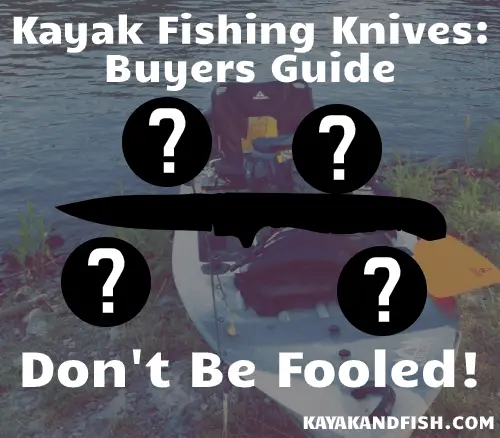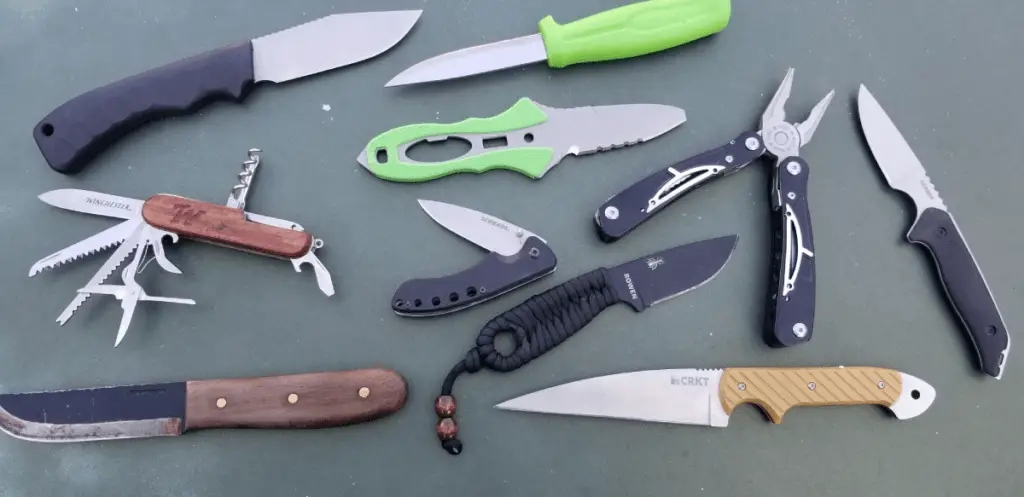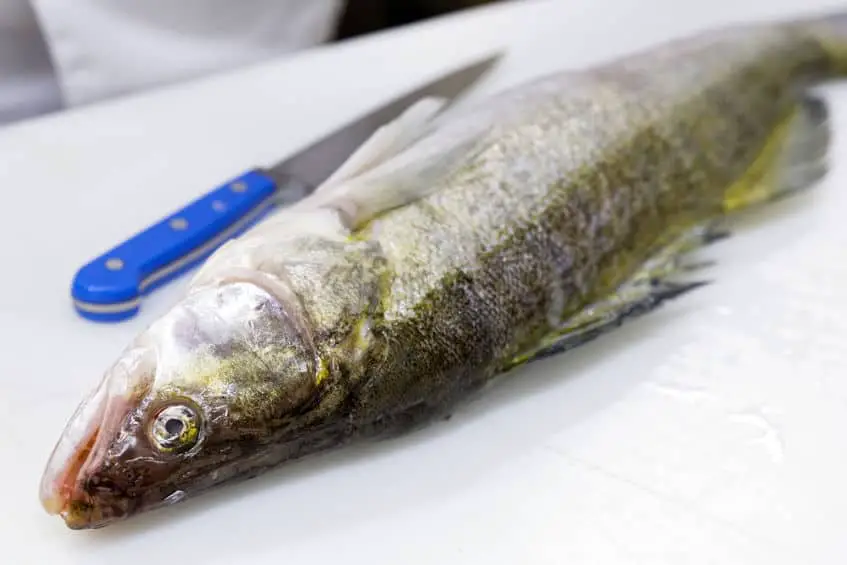
A reliable knife has its place in every hobby and kayak fishing is no exception. I remember being so overwhelmed by the dozens of options when looking for a knife specifically for kayak fishing. I am no stranger to knife making, collecting and use, however, I wanted to make sure I had a definite answer to which knife was best. I sat down and researched to find the best knife for kayak fishing, I used my newfound knowledge and prior experience to find the best knife for the job.
The Best Knife for the Kayak Fisherman
The absolute best knife for kayak fishing that I found is not actually a knife, but a multitool. The Leatherman Wave Multitool is at the top of my list because it is versatile, affordable, and durable.
The Wave (Amazon) is tested, proven, and backed by me. I will not go anywhere without mine. Here are just a few reasons I love mine.

- Stainless Steel
- Boasts 17 tools to tackle any job
- Needs only one hand to open and use
- 25 year limited warranty
- Comes with a high-quality sheath
As far as a budget-friendly option goes, the NRS Co-Pilot (Amazon) is a solid option without sacrificing quality. The Co-Pilot is a fan favorite among many kayak fisherman for good reason.

- Blunted tip protects from unintentional puncture
- Made specifically to fit a PFD (but also fits a belt)
- Comfortable rubberized nonslip grip
- Oxygen tank valve wrench included in the handle
I found a hidden gem of a folding knife too, I use this knife as an EDC (every day carry) instead of kayaking but it would fit that role very well as well. There is nothing wrong with sticking to the basics and the CRKT M16-01KS (Amazon) has them mastered. The only downside here is that this knife misses built-in tools that other options have.

- Stainless Steel
- Under 3 Ounces
- Lifetime Warranty
- Simplistic Design
- Low Cost – High Quality
Check out my Recommended Gear Page for the full range of gear that I recommend.
A Kayak Fishing Knife is NOT Your Every Day Knife
Not just any old knife will do on the water. When it comes to kayak fishing, you’re going to need a durable knife that is built to last and will not fail you when you need it most. A knife that is used for kayak fishing must meet basic requirements to be suitable enough for the job.
Full Tang Construction
Perhaps the most important feature of the best kayak fishing knife is a full tang construction. A full tang knife is where the spine of the blade runs all the way down the length of the knife and handle scales. A full tang knife is more durable than other knives but generally heavier. It is necessary that the knife is lightweight in order to be easily wielded but also durable in order to complete all the tasks thrown at it.
Blade Material
The best knives for kayak fishing have a stainless steel or low carbon steel blade to prevent rust in humid, damp, and wet conditions. Keep in mind that all knives and gear will need care after being in saltwater, regardless of their makeup.
Sheath
Another must-have for the ultimate kayak fishing knife is a durable sheath with the ability to tether to your PFD (Personal Flotation Device). Being able to quickly access your knife is not only convenient but can potentially save your life in an emergency situation.
Grip
The last, but equally important part of the perfect kayaking fishing knife is a rubberized handle or G-10 handle scales to increase grip and durability in wet conditions, other handle materials can crack, fall apart, or retain water. These two options offer the best performance in all conditions.
The Reason You NEED a Kayak Fishing Knife
A knife is one of the most useful tools that someone can carry, especially as a fisherman. You will complete many tasks with your knife such as cutting fishing line, filleting fish, and making cut bait from baitfish, for example. A knife is also a lifesaver in an emergency situation where it can be used to construct shelter and a fire.
It is imperative that you learn to use your knife safely and effectively to prevent injury.
All Knives Are Not Created Equal. What Makes A Good Knife?

There are many things that make up an excellent knife; the most important is the type of steel the knife is constructed from. 420HC (high carbon) stainless steel which is fairly corrosive resistant and offers decent edge retention due to the carbon content of the blade.
A great knife also needs to be affordable but not cheaply made. When it comes to knives, you always get what you pay for. Instead of buying the same cheap knife over and over, invest in a quality knife that will do its job well and last a lifetime.
A good knife tends to be full tang (I touched on this earlier) but a rat tail tang knife is also suitable if not intended for heavy use and abuse.
The knife also needs to be comfortable for hours of use without wearing blisters on your hands.
Simply put, a great knife needs to be cost-efficient, durable, lightweight, and high quality in order to be efficiently used for years. I cannot stress enough the importance of owning a high-quality knife.
A cheap knife will always break before a quality knife will. Instead of buying and breaking a slew of cheap knives, buy a quality knife once.
Normal Knife VS Kayak Fishing Friendly Knife
A “normal knife” can be any type of knife depending on its intended purpose. For example; A kitchen knife’s purpose is to be used in the kitchen so it will be extremely sharp and most likely stainless steel with composite or wood handles. Since the knife is made for the kitchen, it will not be suitable to cut fishing line or use in consistently wet conditions.
A kayak fishing knife has to be corrosion resistant while also staying sharp enough to complete all tasks thrown at it.
One of the most important features of a good kayak fishing knife is a rubberized or G-10 handle, that does not retain water and also ensures you have a good grip on the knife even in wet conditions.
The knife also has to have a good sheath with a drain hole if it is made of Kydex or injection molded plastic so water doesn’t stay in the sheath causing rust.
The last feature is rather it is a fixed blade knife (meaning the knife does not fold and has a sheath to cover the blade), with a full or rat-tail tang. The other option is a folding knife with aluminum or stainless steel handle scales. The choice simply boils down to the preference of which type of knife you want to carry. A fixed blade knife can be mounted either on the kayak, the hip, or the PFD (Personal Floatation Device) for easy access in any situation.
A folding knife can be kept in a pocket or in a tackle box, however, this means it will be harder to get to when you need it. Folding knives are also less durable than a fixed blade knife does to the moving parts that can potentially break.
Most companies that produce high-quality knives have replacement plans and warranties.

Knife vs. Multi-Tool
A knife is a tool that everyone should carry in any situation, from going to the grocery store to being miles away from civilization on a kayak. But you aren’t just limited to a knife while kayak fishing.
There is another alternative like the Leatherman Wave, they have a 25-year warranty, are completely made of stainless steel and come with a leather sheath. The Leatherman wave comes with many tools useful on any fishing adventure including 17 tools such as pliers, screwdrivers, small bit screwdriver, bottle opener, file, saw, can opener, ruler, locking blades and more.
Why Tang Style Matters
Tang is the part of the blade that is covered by the handle.
A full tang knife is where the tang is visible when looking at the handle. Generally, a full tang knife has the handle scales on either side of the tang.
A rattail tang knife is when the profile of the knife slims down resembling a rat’s tail, or a rat tail comb before it transitions to the handle of the knife. Rattail tang knives are less durable than a full tang knife and are more prone to break off at the handle when being beat on and abused. However, both are more durable than a folding knife. There are many different styles of tang but these are the most popular.
Why Sheathes Are Important
Almost all fixed blade knives come with a suitable sheath. However, if the knife tends to be on the lower budget of the spectrum then sometimes they come with a cheap floppy nylon sheath that is just a pain to use. Nylon sheaths retain water, which in turn, causes corrosion. In this case, holes tend to form where the blade slides in and out of the sheath.
The other downside is they do not hold the blade in the sheath very well because usually there is just a flimsy velcro strap or snap button that holds the knife in place. This makes it a burden to attach to a PFD.
On the bright side of things, there are many aftermarket companies that make and sell custom leather or Kydex sheaths for all kinds of different blades shapes and brands. For a kayak fishing knife, Kydex is the best option since they usually are fitted with a drain hole and the knife snaps into place very well ensuring your blade doesn’t fall out while on the water.
There are a plethora of options for mounting with Kydex sheaths. Aftermarket sheaths often times come with molle (modular lightweight load-carrying equipment) options upon request. Molle aids in all sorts of mounting options such as on backpacks and PFDs. This is the preferred option because it is always in reach; even in the event of a capsize.

Blade Temperament, Hardness, and Durability
The temperament of the blade is a direct correlation of how hard, soft, or brittle the metal is. This means that if the blade is hard, that it will be harder to sharpen but will hold a better edge for longer. If the blade is super hard, it won’t bend under immense pressure but will snap instead.
Fear not because quality blades will be just hard enough to keep a razor’s edge and just soft enough to sharpen while having the ability to flex a decent amount under pressure before snapping. The average kayak fisherman will not put a high-quality knife under enough pressure at once to break it.
Even in crazy scenarios, brands like Esee Knives offer a lifetime warranty no matter how the blade breaks they will replace it by mail. You can carelessly break your knife by running over it with an SUV and Esse will replace it, no questions asked.
Versatility in Blade Length
The perfect kayak fishing knife is between 4-6 inches in blade length so that it is not a burden to use or carry.
Blade length is something very important to consider when choosing the perfect kayak fishing knife because your knife doesn’t have to be the size of a katana to be usable.
If the knife is too big it becomes a burden to use and carry. The length of the blade portion of the knife doesn’t need to be much over 4-5 inches to be practical. A knife under 4 inches in some cases cannot complete all the cutting tasks that a knife an inch or two longer can complete.
Whatever You Choose, Don’t Go Cheap!
Remember don’t go cheap but don’t go buy a knife that costs as much as a car payment either. All quality knives are expensive but not all expensive knives are quality. A quality dependable knife will run you anywhere from $40-$120 USD. There are more affordable options but usually, the extra money is worth spending.

